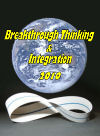
|
|
|
|
Purpose of World Congress On Thinking in a Turbulent Age

|
|
In an unpredictable future, we, the
human race are facing problems we have never encountered before, and
we will experience continued violent, irreversible change in the 21st century
if we cannot change our Thinking Paradigm. We are only now realizing
that conventional Reductionism Thinking, which focuses on past and
present records to analyze the
future, is useless, as no prediction of future is assured by
case studies and detailed analysis of the past. In addition, the
development of the Internet offers us as human beings a new dilemma,
burying us in tons of meaningless information and knowledge.
Effective solutions are buried in a constantly changing current of
data. This phenomenon of “over-information” causes disorder in our
daily lives, and destroys shared human
values.
|
We
are facing the Cognitive Age to learn how to use knowledge
and information beyond the knowledge and information based
society. However, in the aspect of “Future Thinking”, the
status quo still depends on ideas, concepts based on the
past and the present with regards to information and
knowledge. The human race has not been released by
“Reductionism Thinking”, which is the basic thinking
paradigm of a 0-1 based Digital Thinking paradigm popular in
the Information Age. Further more, human beings segment and
reduce all events unconsciously. This segmentation and
reductionism is at root with much of the world’s unsolvable
problems. The ruin of humanity is caused by such digitizing,
producing much conflict and crime, today.
|
|
This second World Congress is based on a new
thinking paradigm called, “Breakthrough Thinking “. Using this new
thinking paradigm, “Breakthrough Thinking “, we can learn to create
future-base solutions, using" Integration Thinking”, a thinking that
regards totality and relation as critical components in solution
creation. This second World Congress is targeted at the future of
human development through people from many different fields, with a
focus on the 21st century
thinking paradigm, “Breakthrough Thinking “ to cope with a “Changing
and turbulent Age “.
|
|
|
|
Concept of Second World Congress :
Makizushi Approach
|
|
1.
Participants: Economist, management, engineer, scholar,
business man , farmer, politician, student, house wife, owner of
restaurant, teacher, philosopher, etc people, group
from all fields will gather.
|
|
|
|
2.
Makizushi
Approach:
(sushi various tasty ingredients rolled in seaweed paper with
harmony) Each group participating has their own planning and
execution of our meeting independently, however , the basic concept
of this meeting focuses to co-opening of the meeting, an integration
of ideas and a co-creation of something essential. To achieve this
goal, a final and total integrated meeting, crossing over all
fields, is held after individual and independent integrated meetings
are held after each field meeting. Deployment of the rolling idea "Makizushi
" and integration will develop a new creative solution process. For
example, integration of each idea or solution based on this new
approach a collaboration between agriculture and industry such as
restaurant, medical and health control, governmental administration
and business management, will be our final output goal. This concept
will create new group of production systems regardless of country
boundaries, new business with encounter of business man and scholar,
new economy system with virtue, study field of economy and
info-psychology will be expected to be co-created in the long run.
|
|
|
|
|
|
| |
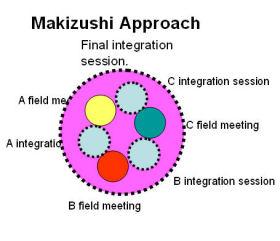 |
|
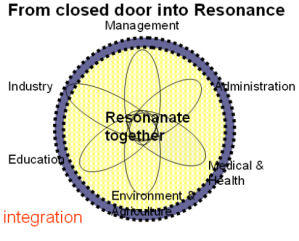 |
|
|
|
Program:
|
|
Aug. 23 (Mon.) |
09:30-17:00 |
Work shop |
|
Aug. 24 (Tue.) |
09:30-16:30 |
Work shop |
|
Optional Tour: Visit Toyota factory, Chukyo University
and
Nagoya City |
|
Aug. 25 (Wed.) |
Morning Session |
Keynote Speech |
|
(1) “21st Century
Breakthrough Thinking” Prof. G. Nadler & Prof. S. Hibino |
|
(2) “ Integration Philosophy” Prof. M. Yoshikawa |
|
Afternoon Session
|
Special
Speech
|
|
(3)
Mr. Teruo Kise TOTO Ltd |
|
(4)
Prof. Kazuhiko Atsumi |
|
(5)
Mr. Katsunari Nishihara |
|
Keynote
Symposium |
|
Welcome Party |
|
Aug. 26 (Thu.) |
Morning & Afternoon Session
|
Makizushi Joint Opening Meeting
|
|
Special
Speech, Research & Case study Presentation same as above |
|
Aug. 27 (Fri.) |
|
Makizushi Joint Opening Meeting |
|
Special
Speech, Research & Case study Presentation same as above |
|
Afternoon Session |
Makizushi Joint Opening Meeting |
|
Total
Integration meeting and announcement of World
Congress Message
|
|
Farewell
Party |
|
|
|
|
Best quality paper will be invited to submit.
Please submit your abstract at The Congress Office.
All submissions must be made no later than Dec. 31, 2009. And
the Deadline for Early Bird Registration is
March 31, 2010.
|
|
|
Registration Fees: |
|
Congress (Three days) |
15,000 Yen |
-
Early
Bird Registration until end of June: 12,000 Yen
- (only for Three
days Registration)
|
|
Congress (One day) |
6,000 Yen |
|
|
Keynote
Speeches:
|
|
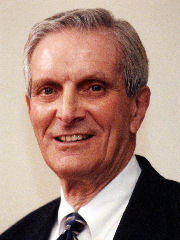 |
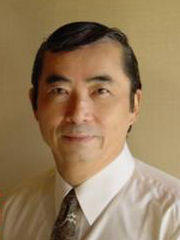 |
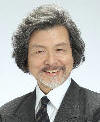 |
|
Gerald Nadler Ph.D. |
|
Professor
emeritus University of Southern
California |
|
|
Shozo Hibino Ph.D. |
|
Professor, Chukyo University |
|
|
Muneo
J.Yoshikawa
Ph.D. |
|
Professor emeritus
University of Hawaii
( Kauai Community
College) |
|
|
Gerald
Nadler is IBM Chair Emeritus in Engineering and Professor
Emeritus of Industrial and System Engineering (ISE) at the
University of Southern California where he was Chairman of
the ISE Department from 1983 to 1993. He also directed USC’s
Center on the Management of Engineering, Research , and
Innovation in Technology (MERIT). He consults and presents
seminars and workshops in all parts of the World. Dr. Nadler
has written over 225 published articles and fifteen books,
several of which are translated
into eight other languages. He has delivered over 800
invited lectures at many universities, companies and
National and international conference, and has been an
invited Visiting Professor at the 5 Universities worldwide.
|
Prof.
Shozo Hibino has created a new thinking paradigm with Dr. Gerald
Nadler and promoted this new thinking paradigm in the world in
21st century
turbulent age. “Breakthrough Thinking” is not only a methodology
but a paradigm shift for a new thinking approach to problems and
solution creation. It involves philosophy, approaches, tools,
and offers a total Solution Creation
framework. It aims to change the current paradigm of the
Scientific Thinking Approach adopted from the Descartes Period,
over 350 years ago. Breakthrough Thinking is now expanding
throughout the world |
Prof.
Muneo J. Yoshikawa and Prof. Shozo Hibino have
conducted
joint research in developing an
“integration philosophy” for the turbulent age of
the 21st Century.
The theory of “Möbius”, proposed by
Dr.Yoshikawa is the
underling theory for this philosophy.“ Breakthrough
Thinking” is also viewed as an integration thinking. Those
two views on integration advocated by Dr.Yoshikawa and Dr.
Hibino as well as by Dr. Nadler will be presented and
explored further at the Congress, with the aim to establish
a new type of integration philosophy.
|
|
|
|
|
|
|
(c) 2009 All right
reserved by the Steering Committee of the 2nd World Congress |
|

